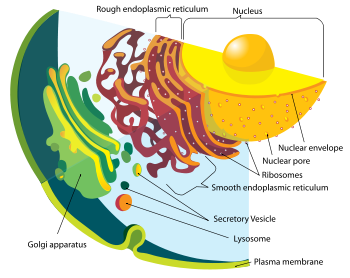- Eukaryote
-
Eukaryotes
Temporal range: Proterozoic – RecentScientific classification Domain: Eukaryota
Whittaker & Margulis,1978Kingdoms Animalia – AnimalsPlantae – PlantsChromalveolataExcavataAlternative phylogeny A eukaryote (pronounced /juːˈkæri.oʊt/ ew-karr-ee-oht or /juːˈkæriət/) is an organism whose cells contain complex structures enclosed within membranes. Eukaryotes may more formally be referred to as the taxon Eukarya or Eukaryota. The defining membrane-bound structure that sets eukaryotic cells apart from prokaryotic cells is the nucleus, or nuclear envelope, within which the genetic material is carried.[1][2][3] The presence of a nucleus gives eukaryotes their name, which comes from the Greek ευ (eu, "good") and κάρυον (karyon, "nut" or "kernel"). Most eukaryotic cells also contain other membrane-bound organelles such as mitochondria, chloroplasts and the Golgi apparatus. All species of large complex organisms are eukaryotes, including animals, plants and fungi, although most species of eukaryote are protist microorganisms.[citation needed]
Cell division in eukaryotes is different from that in organisms without a nucleus (prokaryotes). It involves separating the duplicated chromosomes, through movements directed by microtubules. There are two types of division processes. In mitosis, one cell divides to produce two genetically identical cells. In meiosis, which is required in sexual reproduction, one diploid cell (having two instances of each chromosome, one from each parent) undergoes recombination of each pair of parental chromosomes, and then two stages of cell division, resulting in four haploid cells (gametes). Each gamete has just one complement of chromosomes, each a unique mix of the corresponding pair of parental chromosomes.
Eukaryotes appear to be monophyletic, and so make up one of the three domains of life. The two other domains, Bacteria and Archaea, are prokaryotes and have none of the above features. Eukaryotes represent a tiny minority of all living things; even in a human body there are 10 times more microbes than human cells.[4] However, due to their much larger size their collective worldwide biomass is estimated at about equal to that of prokaryotes.[5]
Contents
Cell features
Eukaryotic cells are typically much larger than those of prokaryotes. They have a variety of internal membranes and structures, called organelles, and a cytoskeleton composed of microtubules, microfilaments, and intermediate filaments, which play an important role in defining the cell's organization and shape. Eukaryotic DNA is divided into several linear bundles called chromosomes, which are separated by a microtubular spindle during nuclear division.
Internal membrane
Eukaryote cells include a variety of membrane-bound structures, collectively referred to as the endomembrane system. Simple compartments, called vesicles or vacuoles, can form by budding off other membranes. Many cells ingest food and other materials through a process of endocytosis, where the outer membrane invaginates and then pinches off to form a vesicle. It is probable that most other membrane-bound organelles are ultimately derived from such vesicles.
The nucleus is surrounded by a double membrane (commonly referred to as a nuclear envelope), with pores that allow material to move in and out. Various tube- and sheet-like extensions of the nuclear membrane form what is called the endoplasmic reticulum or ER, which is involved in protein transport and maturation. It includes the rough ER where ribosomes are attached to synthesize proteins, which enter the interior space or lumen. Subsequently, they generally enter vesicles, which bud off from the smooth ER. In most eukaryotes, these protein-carrying vesicles are released and further modified in stacks of flattened vesicles, called Golgi bodies or dictyosomes.
Vesicles may be specialized for various purposes. For instance, lysosomes contain enzymes that break down the contents of food vacuoles, and peroxisomes are used to break down peroxide, which is toxic otherwise. Many protozoa have contractile vacuoles, which collect and expel excess water, and extrusomes, which expel material used to deflect predators or capture prey. In multicellular organisms, hormones are often produced in vesicles. In higher plants, most of a cell's volume is taken up by a central vacuole, which primarily maintains its osmotic pressure.
Mitochondria and plastids
Mitochondria are organelles found in nearly all eukaryotes. They are surrounded by two membranes (each a phospholipid bi-layer), the inner of which is folded into invaginations called cristae, where aerobic respiration takes place. Mitochondria contain their own DNA. They are now generally held to have developed from endosymbiotic prokaryotes, probably proteobacteria. The few protozoa that lack mitochondria have been found to contain mitochondrion-derived organelles, such as hydrogenosomes and mitosomes; and thus probably lost the mitochondria secondarily.
Plants and various groups of algae also have plastids. Again, these have their own DNA and developed from endosymbiotes, in this case cyanobacteria. They usually take the form of chloroplasts, which like cyanobacteria contain chlorophyll and produce organic compounds (such as glucose) through photosynthesis. Others are involved in storing food. Although plastids likely had a single origin, not all plastid-containing groups are closely related. Instead, some eukaryotes have obtained them from others through secondary endosymbiosis or ingestion.
Endosymbiotic origins have also been proposed for the nucleus, for which see below, and for eukaryotic flagella, supposed to have developed from spirochaetes. This is not generally accepted, both from a lack of cytological evidence and difficulty in reconciling this with cellular reproduction.
Cytoskeletal structures
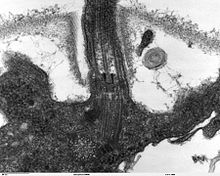 Longitudinal section through the flagellum of Chlamydomonas reinhardtii
Longitudinal section through the flagellum of Chlamydomonas reinhardtii
Many eukaryotes have long slender motile cytoplasmic projections, called flagella, or similar structures called cilia. Flagella and cilia are sometimes referred to as undulipodia,[citation needed] and are variously involved in movement, feeding, and sensation. They are composed mainly of tubulin. These are entirely distinct from prokaryotic flagella. They are supported by a bundle of microtubules arising from a basal body, also called a kinetosome or centriole, characteristically arranged as nine doublets surrounding two singlets. Flagella also may have hairs, or mastigonemes, and scales connecting membranes and internal rods. Their interior is continuous with the cell's cytoplasm.
Microfilamental structures composed by actin and actin binding proteins, e.g., α-actinin, fimbrin, filamin are present in submembraneous cortical layers and bundles, as well. Motor proteins of microtubules, e.g., dynein or kinesin and actin, e.g., myosins provide dynamic character of the network.
Centrioles are often present even in cells and groups that do not have flagella. They generally occur in groups of one or two, called kinetids, that give rise to various microtubular roots. These form a primary component of the cytoskeletal structure, and are often assembled over the course of several cell divisions, with one flagellum retained from the parent and the other derived from it. Centrioles may also be associated in the formation of a spindle during nuclear division.
Significance of cytoskeletal structures is underlined in determination of shape of the cells, as well as their being essential components of migratory responses like chemotaxis and chemokinesis. Some protists have various other microtubule-supported organelles. These include the radiolaria and heliozoa, which produce axopodia used in flotation or to capture prey, and the haptophytes, which have a peculiar flagellum-like organelle called the haptonema. An animal cell is a form of eukaryotic cell that makes up many tissues in animals.
Plant cell wall
Further information: Cell wallPlant cells have a cell wall, a fairly rigid layer outside the cell membrane, providing the cell with structural support, protection, and a filtering mechanism. The cell wall also prevents over-expansion when water enters the cell. The major carbohydrates making up the primary cell wall of land plants are cellulose, hemicellulose, and pectin. The cellulose microfibrils are linked via hemicellulosic tethers to form the cellulose-hemicellulose network, which is embedded in the pectin matrix. The most common hemicellulose in the primary cell wall is xyloglucan.
Differences among eukaryotic cells
There are many different types of eukaryotic cells, though animals and plants are the most familiar eukaryotes, and thus provide an excellent starting point for understanding eukaryotic structure. Fungi and many protists have some substantial differences, however.
Animal cell
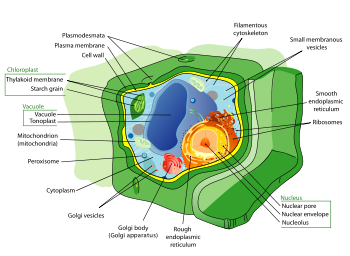 Structure of a typical plant cell
Structure of a typical plant cell
An animal cell is a form of eukaryotic cell that makes up many tissues in animals. The animal cell is distinct from other eukaryotes, most notably plant cells, as they lack cell walls and chloroplasts, and they have smaller vacuoles. Due to the lack of a rigid cell wall, animal cells can adopt a variety of shapes, and a phagocytic cell can even engulf other structures.
There are many different cell types. For instance, there are approximately 210 distinct cell types in the adult human body.
Plant cell
Further information: Plant cellPlant cells are quite different from the cells of the other eukaryotic organisms. Their distinctive features are:
- A large central vacuole (enclosed by a membrane, the tonoplast), which maintains the cell's turgor and controls movement of molecules between the cytosol and sap
- A primary cell wall containing cellulose, hemicellulose and pectin, deposited by the protoplast on the outside of the cell membrane; this contrasts with the cell walls of fungi, which contain chitin, and the cell envelopes of prokaryotes, in which peptidoglycans are the main structural molecules
- The plasmodesmata, linking pores in the cell wall that allow each plant cell to communicate with other adjacent cells; this is different from the functionally analogous system of gap junctions between animal cells.
- Plastids, especially chloroplasts that contain chlorophyll, the pigment that gives plants their green color and allows them to perform photosynthesis
- Higher plants, including conifers and flowering plants (Angiospermae) lack the flagellae and centrioles that are present in animal cells.
Fungal cell
Fungal cells are most similar to animal cells, with the following exceptions:
- A cell wall that contains chitin
- Less definition between cells; the hyphae of higher fungi have porous partitions called septa, which allow the passage of cytoplasm, organelles, and, sometimes, nuclei. Primitive fungi have few or no septa, so each organism is essentially a giant multinucleate supercell; these fungi are described as coenocytic.
- Only the most primitive fungi, chytrids, have flagella.
Other eukaryotic cells
Eukaryotes are a very diverse group, and their cell structures are equally diverse. Many have cell walls; many do not. Many have chloroplasts, derived from primary, secondary, or even tertiary endosymbiosis; and many do not. Some groups have unique structures, such as the cyanelles of the glaucophytes, the haptonema of the haptophytes, or the ejectisomes of the cryptomonads. Other structures, such as pseudopods, are found in various eukaryote groups in different forms, such as the lobose amoebozoans or the reticulose foraminiferans.
Reproduction
Nuclear division is often coordinated with cell division. This generally takes place by mitosis, a process that allows each daughter nucleus to receive one copy of each chromosome. In most eukaryotes, there is also a process of sexual reproduction, typically involving an alternation between haploid generations, wherein only one copy of each chromosome is present, and diploid generations, wherein two are present, occurring through nuclear fusion (syngamy) and meiosis. There is considerable variation in this pattern, however.
Eukaryotes have a smaller surface area to volume ratio than prokaryotes, and thus have lower metabolic rates and longer generation times. In some multicellular organisms, cells specialized for metabolism will have enlarged surface areas, such as intestinal vili.
Origin and evolution
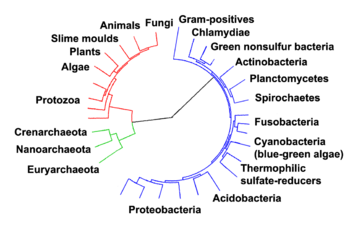 Phylogenetic tree showing the relationship between the eukaryotes and other forms of life.[6] Eukaryotes are colored red, archaea green and bacteria blue.
Phylogenetic tree showing the relationship between the eukaryotes and other forms of life.[6] Eukaryotes are colored red, archaea green and bacteria blue.
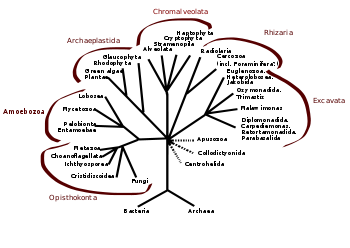 One hypothesis of eukaryotic relationships. The Opisthokonta group includes both animals (Metazoa) and fungi. Plants (Plantae) are placed in Archaeplastida.
One hypothesis of eukaryotic relationships. The Opisthokonta group includes both animals (Metazoa) and fungi. Plants (Plantae) are placed in Archaeplastida.
The origin of the eukaryotic cell was a milestone in the evolution of life, since they include all complex cells and almost all multi-cellular organisms. The timing of this series of events is hard to determine; Knoll (2006) suggests they developed approximately 1.6–2.1 billion years ago. Some acritarchs are known from at least 1650 million years ago, and the possible alga Grypania has been found as far back as 2100 million years ago.[7]
Fossils that are clearly related to modern groups start appearing around 1.2 billion years ago, in the form of a red alga, though recent work suggests the existence of fossilized filamentous algae in the Vindhya basin dating back to 1.6 to 1.7 billion years ago.[8]
Biomarkers suggest that at least stem eukaryotes arose even earlier. The presence of steranes in Australian shales indicates that eukaryotes were present 2.7 billion years ago.[9][10]
Classification
Even back to Antiquity the two clades of animals and plants was recognized. They were given the taxonomic rank of Kingdom (biology) by Linnaeus. Though he included the fungi with plants with some reservations, it was later realized that they are quite distinct and warrant a separate kingdom, the composition of which was not entirely clear until the 1980s.[11] The various single cell eukaryotes were originally placed with plants or animals when they became known. The German biologist Georg A. Goldfuss coined the word protozoa in 1830 to refer to organisms such as ciliates and corals, and this group was expanded until it encompassed all single cell eukaryotes, and given their own kingdom, the Protista by Ernst Haeckel in 1866.[12][13] The eukaryotes thus came to be composed of four kingdoms:
- Kingdom Protista
- Kingdom Plantae
- Kingdom Fungi
- Kingdom Animalia
The protists were understood to be "primitive forms", and thus an evolutionary grade, united by their primitive unicellular nature.[13] The disentanglement of the deep splits in the tree of life only really got going with DNA sequencing, leading to a system of domains rather than kingdoms as top level rank being put forward by Carl Woese, uniting all the eukaryote kingdoms under the eukaryote domain.[14] At the same time, work on the protist tree intensified, and is still actively going on today. Several alternative classifications have been forwarded, though there is no consensus in the field.
A classification produced in 2005 for the International Society of Protistologists,[15] which reflected the consensus of the time, divided the eukaryotes into six supposedly monophyletic 'supergroups'. Although the published classification deliberately did not use formal taxonomic ranks, other sources have treated each of the six as a separate Kingdom.
Excavata Various flagellate protozoa Amoebozoa Most lobose amoeboids and slime moulds Opisthokonta Animals, fungi, choanoflagellates, etc. Rhizaria Foraminifera, Radiolaria, and various other amoeboid protozoa Chromalveolata Stramenopiles (or Heterokonta), Haptophyta, Cryptophyta (or cryptomonads), and Alveolata Archaeplastida (or Primoplantae) Land plants, green algae, red algae, and glaucophytes However, in the same year (2005), doubts were expressed as to whether some of these supergroups were monophyletic, particularly the Chromalveolata,[16] and a review in 2006 noted the lack of evidence for several of the supposed six supergroups.[17]
Phylogeny
rRNA trees constructed during the 1980s and 1990s left most eukaryotes in an unresolved "crown" group (not technically a true crown), which was usually divided by the form of the mitochondrial cristae; see crown eukaryotes. The few groups that lack mitochondria branched separately, and so the absence was believed to be primitive; but this is now considered an artifact of long-branch attraction, and they are known to have lost them secondarily.[18][19]
As of 2011[update], there is widespread agreement that the Rhizaria belong with the Stramenopiles and the Alveolata, in a clade dubbed the SAR supergroup, so that Rhizara is not one of the main eukaryote groups; also that the Amoeboza and Opisthokonta are each monophyletic and form a clade, often called the unikonts.[20][21][22][23][24] Beyond this, there does not appear to be a consensus.
Chromalveolata+Rhizaria
Some analyses disassemble the Chromalveolata+Rhizaria, showing close relationships with the Archaeplastida. For example, in 2007, Burki et al. produced a tree of the form shown below.[20]
eukaryotes SAR = Stramenopiles + Alveolata + Rhizaria
Hacrobia = Haptophyta + Cryptophyta
Amoebozoa
Opisthokonta
Excavata
Bikonts and unikonts
In another analysis, the Hacrobia are shown nested inside the Archaeplastida, which together form a clade with most of the Excavata, before joining the SAR clade of Stramenopiles, Alveolata and Rhizaria. Together all of these groups make up the bikonts, the Amoebozoa and Opisthokonta forming the unikonts.[25]
eukaryotes bikonts Archaeplastida + Hacrobia + Excavata (except Preaxostyla)
Preaxostyla (formerly an excavate group)
SAR = Stramenopiles + Alveolata + Rhizaria
unikonts Amoebozoa
Opisthokonta
The division of the eukaryotes into two primary clades, unikonts and bikonts, derived from an ancestral uniflagellar organism and an ancestral biflagellar organism, respectively, had been suggested earlier.[26][27]
Expanded Chromalveolata
Other analyses place the SAR supergroup within an expanded Chromalveolata, although they differ on the placement of the resulting five groups. Rogozin et al. in 2009 produced the tree shown below, where the primary division is between the Archaeplastida and all other eukaryotes.[28]
eukaryotes Archaeplastida
Excavata (position uncertain)
Chromalveolata (including Rhizaria)
unikonts Amoebozoa
Opisthokonta
More commonly the expanded Chromalveolata is shown as more closely related to the Archaeplastida, producing a tree of the form shown below.[22][24]
eukaryotes Excavata
Chromalveolata (including Rhizaria)
Archaeplastida
unikonts Amoebozoa
Opisthokonta
Alternative views
A paper published in 2009 which re-examined the data used in some of the analyses presented above as well as performing new ones, strongly suggested that the Archaeplastida are polyphyletic. The phylogeny finally proposed in the paper is shown below.[29]
eukaryotes Amoeboza
Opisthokonta
Excavata
Red algae
Glaucophyta
Chromalveolata (including Rhizaria)
Green plants
Overall it seems that although progress has been made, there are still very significant uncertainties in the evolutionary history and classification of eukaryotes. As Roger & Simpson say "with the current pace of change in our understanding of the eukaryote tree of life, we should proceed with caution."[30]
Relationship to Archaea
Eukaryotes are more closely related to Archaea than Bacteria, at least in terms of nuclear DNA and genetic machinery, and one controversial idea is to place them with Archaea in the clade Neomura. However, in other respects, such as membrane composition, eukaryotes are similar to Bacteria. Three main explanations for this have been proposed:
- Eukaryotes resulted from the complete fusion of two or more cells, wherein the cytoplasm formed from a eubacterium, and the nucleus from an archaeon,[31] from a virus,[32][33] or from a pre-cell.[34][35]
- Eukaryotes developed from Archaea, and acquired their eubacterial characteristics from the proto-mitochondrion.
- Eukaryotes and Archaea developed separately from a modified eubacterium.
There is also the Kronocyte theory for the origin of the Eukaryotic cell.[36] This postulates that a primitive Eukaryotic cell emerged from the pre-DNA world but retained the earlier RNA based chemistry from which all modern life emerged. This primitive cell is called the Kronocyte. According to this hypothesis an RNA based Kronocyte coexisted with the DNA based Archaea (and probably eubacteria) and became the modern eukaryotic cell after a number of major endosymbioses—the first was the incorporation of an Archaea that introduced DNA metabolism and the nucleus, then the incorporation of an alphaproteobacter that became the mitochondria (and photosynthetic bacteria found in today's plants as chloroplasts). The Kronocyte hypothesis explains the large number of genes that are today only found in Eukaryotes but not in Archaea or Bacteria.
Endomembrane system and mitochondria
The origins of the endomembrane system and mitochondria are also unclear.[37] The phagotrophic hypothesis proposes that eukaryotic-type membranes lacking a cell wall originated first, with the development of endocytosis, whereas mitochondria were acquired by ingestion as endosymbionts.[38] The syntrophic hypothesis proposes that the proto-eukaryote relied on the proto-mitochondrion for food, and so ultimately grew to surround it. Here the membranes originated after the engulfment of the mitochondrion, in part thanks to mitochondrial genes (the hydrogen hypothesis is one particular version).[39]
In a study using genomes to construct supertrees, Pisani et al. (2007) suggest that, along with evidence that there was never a mitochondrion-less eukaryote, eukaryotes evolved from a syntrophy between an archaea closely related to Thermoplasmatales and an α-proteobacterium, likely a symbiosis driven by sulfur or hydrogen. The mitochondrion and its genome is a remnant of the α-proteobacterial endosymbiont.[40]
See also
References
- ^ Youngson, Robert M. (2006). Collins Dictionary of Human Biology. Glasgow: HarperCollins. ISBN 0-00-722134-7.
- ^ Nelson, David L.; Cox, Michael M. (2005). Lehninger Principles of Biochemistry (4th ed.). New York: W.H. Freeman. ISBN 0716743396.
- ^ Martin, E.A., ed (1983). Macmillan Dictionary of Life Sciences (2nd ed.). London: Macmillan Press. ISBN 0-333-34867-2.
- ^ Zimmer, Carl (13 July 2010). "How Microbes Defend and Define Us". New York Times. http://www.nytimes.com/2010/07/13/science/13micro.html?_r=2&pagewanted=all. Retrieved 17 July 2010.
- ^ Whitman, Coleman, and Wiebe, Prokaryotes: The unseen majority, Proc. Natl. Acad. Sci. USA, Vol. 95, pp. 6578–6583, June 1998
- ^ Ciccarelli FD, Doerks T, von Mering C, Creevey CJ, Snel B, Bork P (2006). "Toward automatic reconstruction of a highly resolved tree of life". Science 311 (5765): 1283–7. Bibcode 2006Sci...311.1283C. doi:10.1126/science.1123061. PMID 16513982.
- ^ Knoll, Andrew H.; Javaux, E.J, Hewitt, D. and Cohen, P. (2006). "Eukaryotic organisms in Proterozoic oceans". Philosophical Transactions of the Royal Society of London, Part B 361 (1470): 1023–38. doi:10.1098/rstb.2006.1843. PMC 1578724. PMID 16754612. http://www.pubmedcentral.nih.gov/articlerender.fcgi?tool=pmcentrez&artid=1578724.
- ^ Bengtson S, Belivanova V, Rasmussen B, Whitehouse M. (2009). The controversial "Cambrian" fossils of the Vindhyan are real but more than a billion years older. Proc Natl Acad Sci U S A. 106: 7729–7734 PubMed
- ^ Brocks JJ, Logan GA, Buick R, Summons RE (August 1999). "Archean molecular fossils and the early rise of eukaryotes". Science 285 (5430): 1033–6. doi:10.1126/science.285.5430.1033. PMID 10446042. http://www.sciencemag.org/cgi/content/full/285/5430/1033.
- ^ Ward P (9 Feb 2008). "Mass extinctions: the microbes strike back". New Scientist: 40–3. http://www.newscientist.com/channel/life/mg19726421.900-mass-extinctions-the-microbes-strike-back.html.
- ^ Moore RT. (1980). "Taxonomic proposals for the classification of marine yeasts and other yeast-like fungi including the smuts". Botanica Marina 23: 361–73.
- ^ Scamardella, J. M. (1999). "Not plants or animals: a brief history of the origin of Kingdoms Protozoa, Protista and Protoctista". International Microbiology 2: 207–221. http://www.im.microbios.org/08december99/03%20Scamardella.pdf.
- ^ a b Rothschild LJ (1989). "Protozoa, Protista, Protoctista: what's in a name?". J Hist Biol 22 (2): 277–305. doi:10.1007/BF00139515. PMID 11542176. http://www.springerlink.com/index/LW54T61737212643.pdf.
- ^ Woese C, Kandler O, Wheelis M (1990). "Towards a natural system of organisms: proposal for the domains Archaea, Bacteria, and Eucarya.". Proc Natl Acad Sci USA 87 (12): 4576–9. Bibcode 1990PNAS...87.4576W. doi:10.1073/pnas.87.12.4576. PMC 54159. PMID 2112744. http://www.pnas.org/cgi/reprint/87/12/4576. Retrieved 11 February 2010.
- ^ Adl SM, Simpson AG, Farmer MA, et al. (2005). "The new higher level classification of eukaryotes with emphasis on the taxonomy of protists". J. Eukaryot. Microbiol. 52 (5): 399–451. doi:10.1111/j.1550-7408.2005.00053.x. PMID 16248873.
- ^ Harper, J. T., Waanders, E. & Keeling, P. J. 2005. On the monophyly of chromalveolates using a six-protein phylogeny of eukaryotes. Int. J. System. Evol. Microbiol., 55, 487-496.[1]
- ^ Laura Wegener Parfrey, Erika Barbero, Elyse Lasser, Micah Dunthorn, Debashish Bhattacharya, David J. Patterson, and Laura A Katz (2006 December). "Evaluating Support for the Current Classification of Eukaryotic Diversity". PLoS Genet. 2 (12): e220. doi:10.1371/journal.pgen.0020220. PMC 1713255. PMID 17194223. http://www.pubmedcentral.nih.gov/articlerender.fcgi?tool=pmcentrez&artid=1713255.
- ^ Tovar J, Fischer A, Clark CG (1999). "The mitosome, a novel organelle related to mitochondria in the amitochondrial parasite Entamoeba histolytica". Mol. Microbiol. 32 (5): 1013–21. doi:10.1046/j.1365-2958.1999.01414.x. PMID 10361303.
- ^ Boxma B, de Graaf RM, van der Staay GW, et al. (2005). "An anaerobic mitochondrion that produces hydrogen". Nature 434 (7029): 74–9. doi:10.1038/nature03343. PMID 15744302.
- ^ a b Fabien Burki, Kamran Shalchian-Tabrizi, Marianne Minge, Åsmund Skjæveland, Sergey I. Nikolaev, Kjetill S. Jakobsen, Jan Pawlowski (2007). "Phylogenomics Reshuffles the Eukaryotic Supergroups". PLoS ONE 2 (8): e790. doi:10.1371/journal.pone.0000790. PMC 1949142. PMID 17726520. http://www.plosone.org/article/info%3Adoi%2F10.1371%2Fjournal.pone.0000790.
- ^ Burki, Fabien; Shalchian-Tabrizi, Kamran & Pawlowski, Jan (2008). "Phylogenomics reveals a new 'megagroup' including most photosynthetic eukaryotes". Biology Letters 4 (4): 366–369. doi:10.1098/rsbl.2008.0224. PMC 2610160. PMID 18522922. http://www.pubmedcentral.nih.gov/articlerender.fcgi?tool=pmcentrez&artid=2610160.
- ^ a b Burki, F. et al.; Inagaki, Y.; Brate, J.; Archibald, J. M.; Keeling, P. J.; Cavalier-Smith, T.; Sakaguchi, M.; Hashimoto, T. et al. (2009). "Large-Scale Phylogenomic Analyses Reveal That Two Enigmatic Protist Lineages, Telonemia and Centroheliozoa, Are Related to Photosynthetic Chromalveolates". Genome Biology and Evolution 1: 231–8. doi:10.1093/gbe/evp022. PMC 2817417. PMID 20333193. http://www.pubmedcentral.nih.gov/articlerender.fcgi?tool=pmcentrez&artid=2817417
- ^ Hackett, J.D.; Yoon, H.S.; Li, S.; Reyes-Prieto, A.; Rummele, S.E. & Bhattacharya, D. (2007). "Phylogenomic analysis supports the monophyly of cryptophytes and haptophytes and the association of Rhizaria with chromalveolates". Mol. Biol. Evol. 24: 1702–13. doi:10.1093/molbev/msm089. PMID 17488740
- ^ a b Cavalier-Smith, Thomas (2009). "Kingdoms Protozoa and Chromista and the eozoan root of the eukaryotic tree". Biology Letters 6: 342–5. doi:10.1098/rsbl.2009.0948. PMC 2880060. PMID 20031978. http://www.pubmedcentral.nih.gov/articlerender.fcgi?tool=pmcentrez&artid=2880060
- ^ Kim, E.; Graham, L.E. & Graham, Linda E. (2008). "EEF2 analysis challenges the monophyly of Archaeplastida and Chromalveolata". PLoS ONE 3 (7): e2621. doi:10.1371/journal.pone.0002621. PMC 2440802. PMID 18612431. http://www.pubmedcentral.nih.gov/articlerender.fcgi?tool=pmcentrez&artid=2440802.
- ^ Thomas Cavalier-Smith (2006). "Protist phylogeny and the high-level classification of Protozoa". European Journal of Protistology 39 (4): 338–348. doi:10.1078/0932-4739-00002.
- ^ Burki F, Pawlowski J (October 2006). "Monophyly of Rhizaria and multigene phylogeny of unicellular bikonts". Mol. Biol. Evol. 23 (10): 1922–30. doi:10.1093/molbev/msl055. PMID 16829542. http://mbe.oxfordjournals.org/cgi/pmidlookup?view=long&pmid=16829542.
- ^ Rogozin, I.B.; Basu, M.K.; Csürös, M. & Koonin, E.V. (2009). "Analysis of Rare Genomic Changes Does Not Support the Unikont–Bikont Phylogeny and Suggests Cyanobacterial Symbiosis as the Point of Primary Radiation of Eukaryotes". Genome Biology and Evolution 1: 99–113. doi:10.1093/gbe/evp011. PMC 2817406. PMID 20333181. http://www.pubmedcentral.nih.gov/articlerender.fcgi?tool=pmcentrez&artid=2817406
- ^ Nozaki H, Maruyama S, Matsuzaki M, Nakada T, Kato S, Misawa K (December 2009). "Phylogenetic positions of Glaucophyta, green plants (Archaeplastida) and Haptophyta (Chromalveolata) as deduced from slowly evolving nuclear genes". Mol. Phylogenet. Evol. 53 (3): 872–80. doi:10.1016/j.ympev.2009.08.015. PMID 19698794. http://linkinghub.elsevier.com/retrieve/pii/S1055-7903(09)00341-8.
- ^ Roger AJ, Simpson AGB. (2009). "Evolution: Revisiting the Root of the Eukaryote Tree". Current Biology 19 (4): R165–7. doi:10.1016/j.cub.2008.12.032. PMID 19243692.
- ^ Martin W (December 2005). "Archaebacteria (Archaea) and the origin of the eukaryotic nucleus". Curr. Opin. Microbiol. 8 (6): 630–7. doi:10.1016/j.mib.2005.10.004. PMID 16242992.
- ^ Takemura M (May 2001). "Poxviruses and the origin of the eukaryotic nucleus". J. Mol. Evol. 52 (5): 419–25. doi:10.1007/s002390010171. PMID 11443345.
- ^ Bell PJ (September 2001). "Viral eukaryogenesis: was the ancestor of the nucleus a complex DNA virus?". J. Mol. Evol. 53 (3): 251–6. doi:10.1007/s002390010215. PMID 11523012.
- ^ Wächtershäuser G (January 2003). "From pre-cells to Eukarya--a tale of two lipids". Mol. Microbiol. 47 (1): 13–22. doi:10.1046/j.1365-2958.2003.03267.x. PMID 12492850.
- ^ Wächtershäuser G (October 2006). "From volcanic origins of chemoautotrophic life to Bacteria, Archaea and Eukarya". Philos. Trans. R. Soc. Lond. B Biol. Sci. 361 (1474): 1787–1808. doi:10.1098/rstb.2006.1904. PMC 1664677. PMID 17008219. http://www.pubmedcentral.nih.gov/articlerender.fcgi?tool=pmcentrez&artid=1664677.
- ^ Hartman H. & Fedorov A. (2002). "The origin of the eukaryotic cell - a genomic investigation". PNAS 99 (3): 1420–1425. doi:10.1073/pnas.032658599. PMC 122206. PMID 11805300. http://www.pubmedcentral.nih.gov/articlerender.fcgi?tool=pmcentrez&artid=122206.
- ^ Jékely G (2007). "Origin of eukaryotic endomembranes: a critical evaluation of different model scenarios". Adv. Exp. Med. Biol. 607: 38–51. doi:10.1007/978-0-387-74021-8_3. PMID 17977457.
- ^ Cavalier-Smith T (1 March 2002). "The phagotrophic origin of eukaryotes and phylogenetic classification of Protozoa". Int. J. Syst. Evol. Microbiol. 52 (Pt 2): 297–354. PMID 11931142. http://ijs.sgmjournals.org/cgi/pmidlookup?view=long&pmid=11931142.
- ^ Martin W, Müller M (March 1998). "The hydrogen hypothesis for the first eukaryote". Nature 392 (6671): 37–41. doi:10.1038/32096. PMID 9510246.
- ^ Pisani D, Cotton JA, McInerney JO (2007). "Supertrees disentangle the chimerical origin of eukaryotic genomes". Mol Biol Evol. 24 (8): 1752–60. doi:10.1093/molbev/msm095. PMID 17504772.
 This article incorporates public domain material from the NCBI document "Science Primer".
This article incorporates public domain material from the NCBI document "Science Primer".External links
- Eukaryotes (Tree of Life web site)
- Prokaryote versus eukaryote, BioMineWiki
- Eukaryote at the Encyclopedia of Life
Eukaryota Bikonta AH/SARAHSARHalvariaHeterokont ("S")Unikonta Apusomonadida (Apusomonas, Amastigomonas) · Ancyromonadida (Ancyromonas) · Hemimastigida (Hemimastix, Spironema, Stereonema)HolozoaDermocystida · IchthyophonidaFilozoaFilastereaCapsaspora · MinisteriaChoanoflagellateaCategories:- Eukaryotes
- Tree of life
Wikimedia Foundation. 2010.

